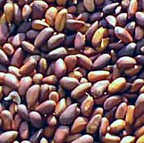The markets are full of basil. The cry goes around the kitchen. “It’s time to make pesto.”
Our recipe is simple. For a small quantity, I use a mortar and pestle. I take a few garlic cloves and pound them into a paste with a little course salt. Then, still using the mortar, I add a handful of basil leaves, a teaspoon or so each of toasted pine nuts and freshly grated Parmesan or Romano cheese, and just enough good olive oil to create a smooth sauce.
 Basil and garlic are in season. Good cheese can often be found on sale. It is only when I have to buy the pine nuts that I pause. Basil and garlic are in season. Good cheese can often be found on sale. It is only when I have to buy the pine nuts that I pause.
“The price has gone down this year,” my corner grocer tells me. “Last year we paid $45 a kilo for pine nuts. This year it’s thirty.” Still, that works out to about $4 for 150 grams. I taste one to make sure that it is nutty and slightly sweet. At that price I want to make sure that they are fresh.
Pine nuts are expensive because it takes a lot of work to get them out. There can be a hundred or so nuts in each pine cone. The cones have to be heated. Then each cone must be cracked without damaging the kernels inside. Pine nuts grow in China, Italy, Afghanistan, Mexico, North Africa and the southwestern United States. There are two main varieties. The Mediterranean or Italian kind come from the stone pine tree. It has a longer shape and a less intense flavour than the Chinese variety.
Pine nuts are higher in protein than most other nuts. They also have a high fat content and can turn rancid quickly. That is why I taste a few before buying. Fortunately, pine nuts keep for a year if stored tightly sealed in a freezer. I always toast pine nuts before I use them to bring out the flavour. This is best done in a frying pan, stirring them every few seconds to make sure that they don’t burn.
We tend to reserve pine nuts for pesto, but elsewhere they have other uses. They are incorporated into Catalan pastries or strewn across almond cakes. They are also tasty stuffed inside a roasting chicken. Afghanistan and Tibet are reputed to have particularly large and potent kernels from the Chilgoza pine. These are eaten as an aphrodisiac. 
|

